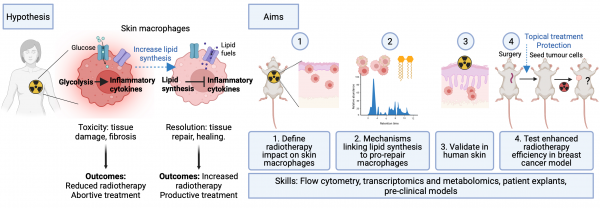Targeting macrophage lipid metabolism to accelerate skin repair during radiotherapy for breast and head and neck cancers
Primary supervisor: Patricia Barral, King’s College London
Secondary supervisor: Clare Bennett, UCL
Project
Radiotherapy is a mainstay of cancer therapeutics but damage to healthy tissue remains the major factor limiting use. In breast and head and neck cancers, skin damage with severe fibrosis at the radiation site is a major adverse event, restricting treatment and imposing poor life quality. Finding approaches for prevention and management of radiation-induced skin toxicities will improve clinical outcomes for cancer patients.
Macrophages are the predominant immune cells in the skin and attractive targets to heal radiotherapy-induced damage due to their unique tissue repair functions. This capability is driven by lipid metabolic programming that switches off pro-fibrotic inflammatory pathways, turning on a tissue restoration state. Recent data from our labs identified new molecular pathways controlling lipid metabolism in macrophages [1,2] and show the importance of lipid metabolism and biosynthesis for the recovery of skin macrophages after total body irradiation [3]. But profibrotic macrophages persist in the skin post-irradiation leading to long-term “immunological scarring” [4].
We aim to determine how radiotherapy alters skin macrophage states and elucidate mechanisms to accelerate skin healing. We hypothesize that manipulating lipid metabolism to activate tissue repair by macrophages will provide a new approach for protecting healthy tissue from radiation induced toxicity and enhance treatment efficacy. Our aims are:
Aim 1. To define normal tissue macrophage responses and the impact of treatment parameters (field, dose), we will use targeted X-ray irradiation at the small animal radiation research platform (UCL Cancer Institute). Combining histology and proteome profiling will determine extent of skin changes, kinetics of resolution, and production of key radiotherapy-induced pro-fibrotic factors in murine skin. Analyses of macrophages by flowcytometry and metabolic profiling will define activation dynamics of cutaneous macrophage populations switching from inflammatory to resolution states.
Aim 2. To determine mechanisms by which activation of lipid metabolism promotes skin repair after radiation we will sequence the transcriptomes and measure the lipidome of cutaneous macrophages. Integration of the datasets will identify lipid pathways and species associated with tissue-repair macrophage functions. In vitro experiments with specific lipids/inhibitors will identify candidates for further testing in vivo.
Aim 3. To investigate the effect of irradiation in human skin, we will take advantage of human skin 3D models developed through our ongoing collaboration with Dr Tom Tull (KCL, St John’s Institute of Dermatology, REC:22/WM/0141). We will perform phenotypical, transcriptional and metabolic analyses of skin macrophages and integrate this with murine data to define the effect of radiation on the immune-metabolic profile of human macrophages and identify conserved mechanisms for clinical translation.
Aim 4. To demonstrate improved clinical efficacy, we will topically apply radioprotective lipids/metabolic activators to mice receiving sham surgery alone or with seeding of small numbers of orthotopic breast cancer (E0771) or head and neck cancer cells (JC1-2) to model residual disease. Outcomes will be skin toxicity, kinetics of tissue repair and tumour regrowth. Professor Hodivala-Dilke has these models established in her lab [5] and will support this aim.

Candidate background
Motivated candidates with strong backgrounds in cancer/skin biology/immunology. They will receive comprehensive training in wet-lab techniques (flow-cytometry, imaging, metabolic assays) computational metabolomics/transcriptomics, and pre-clinical tumour models.
Potential Research Placements
- James Macrae, Francis Crick Institute
- Maria Secrier, Cancer Institute, UCL
- Kairbaan Hodivala-Dilke, Barts Cancer Institute, Queen Mary University of London
References
- Brailey et al. CD1d-dependent rewiring of lipid metabolism in macrophages regulates innate immune responses (2022) Nature Communications doi.org/10.1038/s41467-022-34532-x (Barral lab)
- Lebrusant-Fernandez et al. IFN-g-dependent regulation of intestinal homeostasis by NKT cells (2024) Cell reports DOI: doi: 10.1016/j.celrep.2024.114948 (Barral lab)
- Appios et al. Convergent evolution of monocyte differentiation in adult skin instructs Langerhans cell identity. (2024) Science Immunol doi: 10.1126/sciimmunol.adp0344. (Bennett lab)
- West et al. Loss of T cell tolerance in the skin following immunopathology is linked to failed restoration of the dermal niche by recruited macrophages (2022) Cell Reports doi: 10.1016/j.celrep.2022.110819. (Bennett lab)
- Wong et al. Cancer Burden Is Controlled by Mural Cell-β3-Integrin Regulated Crosstalk with Tumor Cells (2020) Cell DOI: 10.1016/j.cell.2020.02.003 (Hodivala-Dilke lab).
